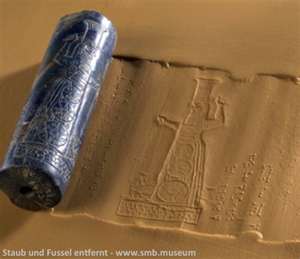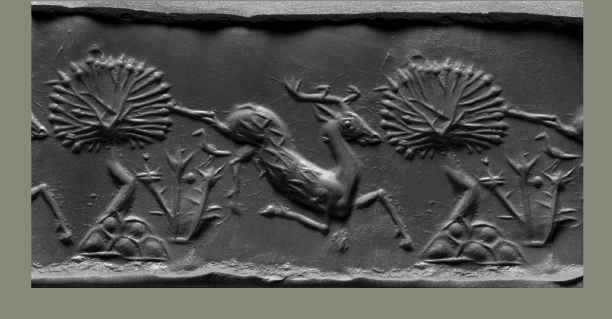In this series of posts I will explore ancient (and possibly modern) artifacts that relate to matters of faith and aesthetic desire. Among artifacts of the lands of the Bible, called by scholars the Ancient Near East (ANE), no object is more ubiquitous than the lowly cylinder seal, an item similar in size and shape to a wine bottle cork that, when rolled over clay, creates a miniature “cartoon strip” of people, animals, plants and gods. When I give tours at Emory University’s ancient art museum several times throughout the year, these items in its permanent collection are my favorite to view and discuss with my guests.
In the ANE, the cylinder seal was developed for the purpose, among other things, of proving ownership or authorization, a signature of sorts, or a personal trademark. The carved surface of the small cylinder was impressed upon the clay of jars, contracts and other objects where identification or authorization was desired, leaving a unique, repeating visual pattern. The seal was typically carved from stone and worn like around the neck like jewellry or an amulet, with a hole drilled lengthwise for the insertion of a cord. Unlike larger sculpture or monumental art, cylinder seals were better suited to survive the destruction of time and, as a result, we have an ample supply of them providing a 3,000 year visual record of ANE life in a chronological sequence, showing how dress, tools, religious icons changed over time.
Cylinder seals have also impressed themselves on the text of the Hebrew Bible in several memorable ways, one of many examples where ANE art illuminates our appreciation of its poetry and narratives. My favorite “cylinder seal story” in the Hebrew Bible involves Judah, son of Jacob, and his daughter-in-law, Tamar, one of several resourceful women of the Hebrew Bible. This Coen Brothers-esque story can be found in Genesis 37.
When Judah’s oldest 2 sons suffer mysterious deaths in connection with marriages (the 2nd being a levirate arrangement, as was the custom) to Tamar, neither of which provides offspring for her, Judah, concerned about this unlucky streak, decides to postpone yet another levirate marriage to his 3rd son. Intrepid Tamar, unafraid to take matters into her own hands in order to make things happen, however, decides to cast off her mourning clothes and impersonate a prostitute and head Judah himself off at the pass in order to impregnate herself and provide children for her deceased first husband. Judah, while a willing customer at this “rest stop” on his journey, has no suitable form of payment for the disguised Tamar, but the parties agree that she may take some collateral to secure Judah’s future payment of a goat for Tamar’s services. The collateral Judah gives Tamar consists of Judah’s staff and his cylinder seal. When Judah’s servant returns with the payment of a goat after their transaction was complete, the prostitute is nowhere to be found, having performed a 3 Nephite-worthy vanishing act.
Three months or so later, still unmarried Tamar is found pregnant and brought to Judah for judgment for her apparent crime. When Judah says she is worthy of capital punishment and demands to know which man was her partner in crime, she pulls out the staff and seal of Judah, displaying them for all to see, and says: “It is the man who owns this staff and this seal.” Judah, unable to overcome the Exhibit A of his very own cylinder seal bearing his name/trademark inscribed on its surface, commutes Tamar’s sentence and admits that he, Judah, was in the wrong and that Tamar had acted correctly to insure the continuation of her deceased first husband’s seed.
Cylinder seals are also featured in another not-ready-for-prime-Sunday-school-time biblical setting, the Song of Solomon. Perhaps resting her head upon his arm and chest, the Song of Solomon female protagonist says to her lover:
“Place me like a seal over your heart, like a seal on your arm; for love is as strong as death, its jealousy unyielding as the grave. It burns like blazing fire, like a mighty flame.” (NIV Song of Solomon 8:6)
In addition to this direct reference above to a cylinder seal worn by her beloved, the poetess also expresses what might be an indirect reference to one of the more popular cylinder seal scenes–a leaping deer–as shown in the seal below:
“The voice of my beloved! behold, he cometh leaping upon the mountains, skipping upon the hills. My beloved is like a roe or a young hart!” (KJV Song of Solomon 2:8-9)
What I love most about this wonderful cylinder seal impression is the “kick up your heels” joy evident in the cavorting deer’s attitude, as well as its hint of a Mona Lisa smile.
What objects intersect with your faith and desire?



I owe part of my title and many of my observations on the jumping deer seal and the Song of Solomon to a lecture by Sidney Babcock, curator at The Pierpont Morgan Library in NY.
Wow, Ed. This is really interesting. I’ve never heard of a cylinder seal before!
I feel like objects are less important to Mormons (or at least to *this* Mormon) than they are to some religious people who wear cross jewelry or who have rosary beads, etc.
I know some people keep a white handkerchief used at a temple ceiling when we all do the “Hallelujah” chorus. I think I have a couple of those somewhere, but they’re not particularly meaningful to me . . .
I’ll keep thinking. ;)
This is really very interesting. I have a real fascination with religious objects and look forward to more of your posts.
Thanks CWO!
Wow! This is a particular of the extremely useful sites We’ve ever arrive across with this topic. Fundamentally Spectacular. I’m in addition a professional on this subject matter so i could understand your effort.